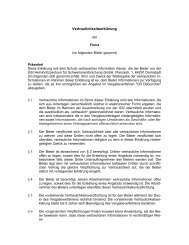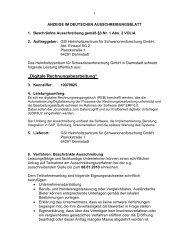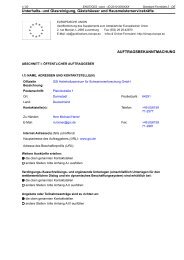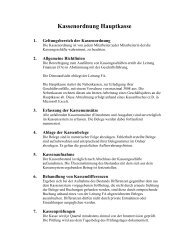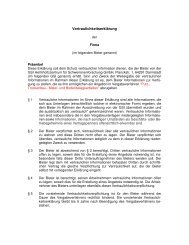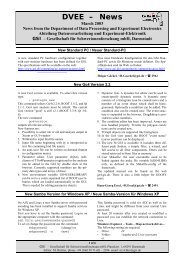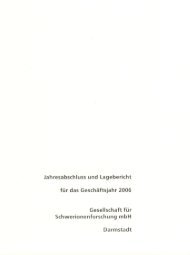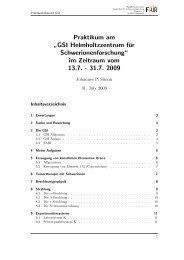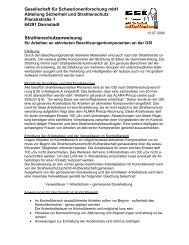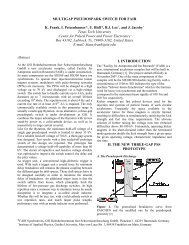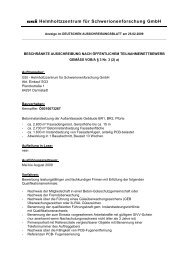Dileptons from Resonance Matter and the DLS Puzzle :
Dileptons from Resonance Matter and the DLS Puzzle :
Dileptons from Resonance Matter and the DLS Puzzle :
You also want an ePaper? Increase the reach of your titles
YUMPU automatically turns print PDFs into web optimized ePapers that Google loves.
<strong>Dileptons</strong> <strong>from</strong> <strong>Resonance</strong> <strong>Matter</strong><br />
<strong>and</strong> <strong>the</strong> <strong>DLS</strong> <strong>Puzzle</strong> :<br />
Recent results <strong>from</strong> HADES<br />
Béatrice Ramstein<br />
Institut de Physique Nucléaire d’Orsay, France
Outline<br />
On related topics, topics,<br />
this morning … B. Kämpfer<br />
V. Metag’s<br />
Introduction: motivations <strong>and</strong> role of Δ resonance<br />
The DiLepton Spectometer puzzle:<br />
comparison of HADES <strong>and</strong> <strong>DLS</strong> C+C 1 AGeV dilepton<br />
spectra<br />
Discussion of HADES C+C, pp <strong>and</strong> pn data<br />
briefly…some<br />
briefly some o<strong>the</strong>r results<br />
Conclusion <strong>and</strong> outlook<br />
ISHIP 2008, GSI Beatrice Ramstein, IPN Orsay, France 2
The Collaboration<br />
SIS<br />
� Catania (INFN - LNS), Italy<br />
� Cracow (Univ.), Pol<strong>and</strong><br />
� Darmstadt (GSI), Germany<br />
� Dresden (FZD), Germany<br />
� Dubna (JINR), Russia<br />
� Frankfurt (Univ.), Germany<br />
� Giessen (Univ.), Germany<br />
� Milano (INFN, Univ.), Italy<br />
� München (TUM), Germany<br />
� Moscow (ITEP,MEPhI,RAS), Russia<br />
� Nicosia (Univ.), Cyprus<br />
� Orsay (IPN), GSI<br />
France<br />
� Rez (CAS, NPI), Czech Rep.<br />
� Sant. de Compostela (Univ.), Spain<br />
� Valencia (Univ.), Spain<br />
� Coimbra (Univ.), LIP, Portugal<br />
ISHIP 2008, GSI Beatrice Ramstein, IPN Orsay, France 3
Motivations of HADES experiment<br />
RHIC<br />
SPS<br />
AGS<br />
hadrons<br />
QGP<br />
SIS‐100<br />
SIS‐300<br />
SIS‐18<br />
KEK,JLAB,TAPS<br />
From B.J. Schäfer, J. Wambach priv. communication<br />
Instrumental challenge!<br />
– Low dilepton pair yields <strong>from</strong> vector<br />
meson<br />
~ 1 reaction per 10 5 -10 6 !<br />
– Conversion:<br />
main source π 0 � γγ (BR 99%)<br />
– Combinatorial background<br />
Di leptons : penetrating probes<br />
� medium modifications of vector meson<br />
properties (ρ,ω)<br />
� electromagnetic structure of hot <strong>and</strong> dense<br />
baryonic matter<br />
� ρ/ρ o ~ 1-3, T < 100 MeV<br />
� N π /A part ≈ 10%<br />
ISHIP 2008, GSI Beatrice Ramstein, IPN Orsay, France 4
Specificity of 1-2 1 2 A GeV energy range<br />
� long life time of <strong>the</strong> dense system<br />
(up to 15 fm/c) τ ρ ~ 1.3 fm/c, τ ω ~ 23 fm/c<br />
� dominance of Δ resonance<br />
UrQMD calculations Au+Au 1 AGeV<br />
� resonance matter (Δ33 ) ρ/ρ0<br />
1-2 GeV<br />
↔<br />
Δ<br />
tot<br />
ISHIP 2008, GSI Beatrice Ramstein, IPN Orsay, France 5<br />
π<br />
N -1<br />
ρ/ρ 0<br />
ρ/ρ 0<br />
n,p<br />
Δ<br />
15 fm/c<br />
Δ Δ<br />
π<br />
N -1
!<br />
inconsistent formula can<br />
be found in litterature<br />
Δ Dalitz decay: decay:<br />
what is known? known?<br />
exact QED calculation :<br />
3 amplitudes: e.g. Magnetic, Electric <strong>and</strong> Coulomb<br />
( ) ( ) ( ) ( ) ⎟ ⎟<br />
2<br />
⎛<br />
⎞<br />
2 ⎜ 2<br />
2 q<br />
2<br />
2<br />
2 2<br />
m , ⎜ q + 3 q + q<br />
2<br />
Δ q G M G E<br />
C<br />
+ -<br />
dΓ(Δ<br />
→ Ne e )<br />
= f 2 dq<br />
G<br />
⎜<br />
2<br />
⎝<br />
m Δ<br />
Form factors G M (q 2 ), G E (q 2 ), G C (q 2 )<br />
q 2 ≥0 : « Time like « electromagnetic structure of N - Δ transition<br />
known only at q 2 =0 ( γN → Δ → πN)<br />
G M (0)=3, G E (0)=0.04, G C (0)=0.2<br />
radiative decay: Δ→Nγ BR=0.56%±0.06%<br />
ISHIP 2008, GSI Beatrice Ramstein, IPN Orsay, France 6<br />
⎠<br />
Δ + →pe + e -<br />
Δ +<br />
q 2 = M 2 inv (e+ e - ) = M γ* 2 > 0<br />
Not measured<br />
p<br />
γ*<br />
e -<br />
Dalitz decay<br />
Δ + → γp<br />
Δ +<br />
q 2 = 0<br />
p<br />
γ<br />
e +<br />
Radiative decay
Δ Dalitz decay : form factors<br />
Form factors G M (q 2 ), G E (q 2 ), G C (q 2 )<br />
« photon point » G M(0)=3, G E (0)=0.04, G C (0)=0.2<br />
in transport models :<br />
constant G M : HSD, IQMD, UrQMD<br />
extended-VDM extended VDM model: model:<br />
RQMD<br />
G M (q 2 )<br />
0.6m 2 ρ<br />
two component Iachello<br />
model = « VMD like »<br />
Wan & Iachello, Iachello,<br />
int. int.<br />
J. Mod. Mod.<br />
Phys. A<br />
20(2005) 1846 1846<br />
dΓ/dM<br />
MΔ =1232 MeV/c2 GM =3.0<br />
GM (q2 ) Iachello<br />
M Δ =1480 MeV/c 2<br />
(E th =1.25 GeV)<br />
M Δ =1830 MeV/c 2<br />
(E th =2.2 GeV)<br />
Δ Dalitz decay<br />
branching ratio<br />
BR ~ 4.2 10 -5<br />
M ee (GeV/c 2 )<br />
ISHIP 2008, GSI Beatrice Ramstein, IPN Orsay, France 7
The DiLepton Spectrometer puzzle<br />
ISHIP 2008, GSI Beatrice Ramstein, IPN Orsay, France 8
A prominent result in <strong>the</strong> 1-2 1 2 AGeV energy range:<br />
Dilepton Spectrometer at <strong>the</strong> Bevalac<br />
The puzzle !<br />
Calculation: E.L.Bratkovskaya et al.<br />
Phys. Lett. B445 (1999) 265<br />
Observed excess remained<br />
unexplained over years<br />
Porter et al., Phys. Rev. Lett 79 (1997)<br />
Calculation: Ernst et al.<br />
Phys. Rev. C58 (1998) 447<br />
Calculation: C. Fuchs et al.<br />
Phys. Rev. C68 (2003) 014904<br />
ISHIP 2008, GSI Beatrice Ramstein, IPN Orsay, France 9<br />
1 AGeV
Acceptance: Full azimuth, polar angles 18 o -85 o<br />
Pair acceptance ≈ 0.35<br />
Particle identification:<br />
RICH, Time Of Flight, Pre-Shower (pad<br />
chambers & lead converter) ( also MDC (K ± ))<br />
Trigger:<br />
1st Level: charged particle multiplicity (~10 kHz)<br />
2' Level: single electron trigger (~2.5 kHz)<br />
Momentum measurement<br />
Magnet: ∫Bdl = 0.1-0.34 Tm<br />
MDC: 24 Mini Drift Chambers<br />
Leptons: Δx~ 140 μ per cell, Δp/p ~ 1-2 %<br />
ΔM/M ~ 2% at ρ mass<br />
HADES<br />
2 nd generation dilepton<br />
spectrometer<br />
START<br />
Side View<br />
ISHIP 2008, GSI Beatrice Ramstein, IPN Orsay, France 10<br />
FW
Dielectron DATA analysis: analysis<br />
normalization to π0 (Nπo (N = ½ (N π- + N π+)) ))<br />
Comb. Background (CB) subtraction<br />
Mee ee < 150 MeV/c 2 Like-sign Like sign pairs<br />
Mee ee > 150 MeV/c 2 event mixing<br />
Signal: ~ 18400 counts<br />
Me+e- ≥ 150 MeV/c2 : ~ 646 counts<br />
Efficiency correction<br />
Measured rates span over 5<br />
orders of magnitude<br />
Systematic errors:<br />
20% efficiency correction<br />
10% combinatorial background<br />
15% π 0 normalization<br />
22% - 27% Total<br />
ISHIP 2008, GSI Beatrice Ramstein, IPN Orsay, France 11
HADES <strong>and</strong> <strong>DLS</strong> Phase Space Coverage<br />
mid-rapidity<br />
HADES<br />
<strong>DLS</strong><br />
mid-rapidity<br />
Method for HADES/<strong>DLS</strong> comparison:<br />
� HADES yield extrapolated to full phase space.<br />
� <strong>DLS</strong> acceptance filter applied<br />
ISHIP 2008, GSI Beatrice Ramstein, IPN Orsay, France 12
C+C 1 A GEV : result of HADES / <strong>DLS</strong> comparison<br />
HADES/<strong>DLS</strong> M e+e- spectra HADES/<strong>DLS</strong> pt spectra<br />
HADES: G. Agakishiev et al., PLB 663<br />
(2008) 43<br />
<strong>DLS</strong>: J. Carroll – presentation<br />
International Workshop on Soft Dilepton Production<br />
August 20-22,1997, LBNL<br />
ISHIP 2008, GSI Beatrice Ramstein, IPN Orsay, France 13<br />
<strong>DLS</strong> data confirmed → dilepton enhancement has to be explained !!
Comparison of HADES Data with Simulated Dilepton Cocktails<br />
PLUTO event generator I. Froehlich et al., al. arXiv:0708.2382<br />
Excess in <strong>the</strong> intermediate mass region<br />
�Cocktail A: π 0 + η + ω<br />
= “long-lived” components only<br />
� π 0 → e + e - γ (Dalitz) , η → e + e - γ (Dalitz)<br />
� ω→ e + e - (direct) , ω →e + e - π 0 (Dalitz)<br />
� π 0 /η constrained by TAPS data<br />
Cocktail B: Cocktail A + Δ + ρ<br />
= “short-lived”<br />
“short lived” sources added<br />
� Δ → e + e - p (Dalitz decay)<br />
N(Δ) =3/2 N( π 0 )<br />
� ρ → e + e - (direct)<br />
ISHIP 2008, GSI Beatrice Ramstein, IPN Orsay, France 14
Cocktail A: π0 Excess yield scales like π<br />
+ η + ω<br />
= “long-lived” components only<br />
0<br />
(related to Δ in cocktail)<br />
π<br />
Δ regeneration<br />
Δ N →<br />
←<br />
NN<br />
Comparison of HADES Data with Pluto Cocktails<br />
N -1<br />
Δ<br />
π<br />
Δ<br />
Excess in <strong>the</strong> intermediate<br />
Need for transport<br />
mass region<br />
models<br />
ISHIP 2008, GSI Beatrice Ramstein, IPN Orsay, France 15<br />
N -1
New <strong>the</strong>oretical calculations !!<br />
1997: transport models failed to explain <strong>DLS</strong> data<br />
2007: <strong>DLS</strong> <strong>and</strong> HADES agree <strong>and</strong> are compatible with new transport model<br />
calculations<br />
Calculation: E.L.Bratkovskaya et al.<br />
HSD Giessen<br />
Nucl. Phys. A634 (1998) 168<br />
E. Bratkovskaya <strong>and</strong> W.Cassing, nucl-th/0712.0635<br />
1/N 0 dN/dM [1/GeV /c<br />
π 2<br />
]<br />
10 -2<br />
10 -3<br />
10 -4<br />
10 -5<br />
10 -6<br />
10 -7<br />
10 -8<br />
C+C, 1.0 A GeV<br />
no medium effects<br />
HADES<br />
HADES <strong>DLS</strong><br />
0.0 0.2 0.4 0.6 0.8<br />
M [GeV/c²]<br />
HSD:<br />
π 0<br />
Dalitz<br />
η Dalitz<br />
Δ Dalitz<br />
ω Dalitz<br />
ω<br />
ρ<br />
Brems. NN<br />
Brems. πN<br />
All<br />
dσ/dM [μb/(GeV c 2<br />
)]<br />
0.0 0.1 0.2 0.3 0.4 0.5 0.6 0.7 0.8 0.9<br />
M [GeV/c²]<br />
new treatments of Bremsstrahlung: R. Shyam & U.Mosel, PRC67 (2003) 065202<br />
L.P. Kaptari, B. Kämpfer, NPA 764 (2006) 338<br />
ISHIP 2008, GSI Beatrice Ramstein, IPN Orsay, France 16<br />
10 2<br />
10 1<br />
10 0<br />
10 -1<br />
10 -2<br />
10 -3<br />
C+C, 1.04 A GeV<br />
no medium effects<br />
<strong>DLS</strong><br />
<strong>DLS</strong><br />
π 0 Dalitz<br />
η Dalitz<br />
Δ Dalitz<br />
ω Dalitz<br />
ω<br />
ρ<br />
Brems. NN<br />
Brems. πN<br />
All
Soft photon approximation<br />
γ*<br />
γ*<br />
Full OBE: meson exchange currents<br />
R. Shyam & U.Mosel, PRC67 (2003) 065202<br />
+<br />
N,Δ<br />
Kaptari&Kämpfer, NPA 764 (2006) 338<br />
Gauge invariance → contact terms<br />
NN Bremsstrahlung:<br />
Amplitude calculated for real photon<br />
+ phase space correction<br />
pn Bremsstrahlung by Kaptari & Kämpfer<br />
factor 4 larger than SPA<br />
Same result for pp Bremsstrahlung, Bremsstrahlung,<br />
but still<br />
much smaller than pn<br />
Δ graphs also present<br />
ISHIP 2008, GSI Beatrice Ramstein, IPN Orsay, France 17
BUU Barz et al.<br />
More transport models results ....<br />
RQMD: E.Santini et al<br />
UrQMD Bleicher et al. IQMD Thomere et al.<br />
Δ Dalitz<br />
pn<br />
C+C 2 AGeV<br />
pn Bremsstrahlung <strong>and</strong> Delta Dalitz decay<br />
Important issues for underst<strong>and</strong>ing<br />
intermediate mass dilepton yield<br />
Need for elementary pp, pn reactions<br />
ISHIP 2008, GSI Beatrice Ramstein, IPN Orsay, France 18
pp reaction at 1.25 GeV: GeV:<br />
Δ Dalitz decay<br />
LH2 target, normalisation to elastic scattering<br />
(syst.error ~ 30 %)<br />
preliminary<br />
E=1.25 GeV < η threshold<br />
pp Bremsstrahlung is small<br />
Pluto simulations<br />
1) pp→pΔ pp +<br />
σ(pp pp→pΔ + ) = 6 mb<br />
~ 3/2 σ(pp pp→pπ° )<br />
Δ Dalitz decay <strong>from</strong> QED vertex<br />
a) G M=3 =3<br />
b) Iachello GM (q 2 )<br />
2) dσ/dM d dM <strong>from</strong> OBE model (Kaptari ( Kaptari & Kämpfer) K mpfer)<br />
with assumption on γ* * angular distribution<br />
a) Delta graphs only<br />
b) all graphs ( bremstrahlung +FSI)<br />
Dalitz decay <strong>from</strong> simple model + Iachello G M (q 2 ) OK<br />
BR ~ 4.2 10 -5 sensitivity to N-Δ electromagnetic structure !<br />
G M (q 2 )<br />
Even better<br />
in exclusive<br />
e + e - p events<br />
ISHIP 2008, GSI Beatrice Ramstein, IPN Orsay, France 19<br />
p<br />
p<br />
Δ +<br />
p<br />
p<br />
γ*<br />
e --<br />
e +
Dilepton spectra in OBE :<br />
a « hot » <strong>and</strong> controversial subject<br />
------ Kaptari <strong>and</strong> Kämpfer<br />
___ Shyam <strong>and</strong> Mosel<br />
Δ <strong>from</strong> our model:<br />
pp→pΔ pp→p + ~ 6 mb<br />
np →nΔ →n + ~ 12 mb<br />
Δ Dalitz decay : GM =3<br />
p<br />
p<br />
G M (q 2 )<br />
Δ +<br />
p<br />
p<br />
γ*<br />
e --<br />
e +<br />
……..… news <strong>from</strong> last week ……………….<br />
arXiv:nucl-th 08110739 Shyam <strong>and</strong> Mosel<br />
« Dilepton production in nucleon-nucleon revisited »<br />
including Δ contribution<br />
Dilepton spectra in 4π acceptance<br />
M(GeV/c 2 )<br />
ISHIP 2008, GSI Beatrice Ramstein, IPN Orsay, France 20
dp at 1.25 GeV: GeV:<br />
pn Bremstrahlung sensitivity<br />
selection of np reactions: spectator<br />
proton in Forward Wall ( 0.5°–7°)<br />
Test of pn bremsstrahlung contribution<br />
Fermi momentum → η contribution<br />
normalisation to elastic scattering<br />
(syst.error ~ 30 %)<br />
PRELIMINARY<br />
PRELIMINARY<br />
HADES np data: a new puzzle ??<br />
PLUTO simulations<br />
1) σ (np np→nΔ+) = 12 mb ~ 3/2 σ(np np→np npπ°)<br />
η production (COSY/CELSIUS) added<br />
2) Kaptari <strong>and</strong> Kämpfer full OBE<br />
CC scales as ½(pp+pn) !!<br />
no enhancement ?<br />
PRELIMINARY<br />
ISHIP 2008, GSI Beatrice Ramstein, IPN Orsay, France 21
2001/2<br />
2004<br />
2004<br />
2005<br />
2006<br />
2007<br />
2007<br />
2008<br />
HADES experimental program<br />
C + C 2 AGeV<br />
C + C 1 AGeV<br />
p + p 2.2 GeV<br />
pp elastic,<br />
exclusive ppe+e- ppe+e (π°,η)<br />
Ar + KCl 1.75 AGeV<br />
p + p 1.25 GeV<br />
exclusive ppe+e- ppe+e (π°,Δ)<br />
p + p 3.5 GeV<br />
d + p 1.25 AGeV<br />
p+Nb 3.5 GeV<br />
1 PRL (e+e-) + 1 submitted (hadron)<br />
1 PLB (e+e-) + 1 submitted (hadron)<br />
Analysis finished (draft)<br />
Validation of detector performance,<br />
measures of π° <strong>and</strong> η Dalitz decays (helicity<br />
distribution), “free” cocktail<br />
Analysis ongoing dielectron spectra, medium<br />
effects<br />
inclusive analysis finished (draft)<br />
Δ Dalitz decay first measurement<br />
ω line shape <strong>and</strong> cocktail (π, Δ, η, ω, ρ, φ...)!<br />
Contribution of pn Bremstrahlung / Δ Dalitz decay<br />
Reference for medium effects<br />
ISHIP 2008, GSI Beatrice Ramstein, IPN Orsay, France 22
First peaks at 3.5 GeV<br />
ω→e + e - decay observed for a first time at SIS/Bevalac energy<br />
Cocktail normalized to π° (no abs. norm.)<br />
pp at 3.5 GeV<br />
Δ<br />
η<br />
Mass resolution in <strong>the</strong><br />
ω region < 2,7 %<br />
Apr 2007<br />
ρ<br />
π0 ω<br />
PRELIMINARY<br />
φ<br />
pNb at 3.5 GeV<br />
Oct 2008<br />
On-line pNb spectrum<br />
PRELIMINARY<br />
ISHIP 2008, GSI Beatrice Ramstein, IPN Orsay, France 23
Hadronic channels: channels:<br />
high quality by-products<br />
by products !!<br />
M nπ+<br />
pp→pnπ + E=1.25 GeV<br />
Δ production mechanism<br />
Submitted to EPJA<br />
C+C<br />
1 <strong>and</strong> 2 AGeV<br />
π ± mt spectra<br />
Δ ++ M pπ+<br />
pn FSI<br />
pp elastic scattering<br />
Data normalisation <strong>and</strong> consistency checks<br />
First φ mt spectrum at SIS<br />
Ar+KCl<br />
1.75 AGeV<br />
ISHIP 2008, GSI Beatrice Ramstein, IPN Orsay, France 24<br />
SQM08
Exclusive reconstruction of <strong>the</strong> π,η → γe + e- Δ1232<br />
π<br />
N1440 N1535 Δ1600<br />
Yields <strong>and</strong> invariant mass<br />
agree with resonance model<br />
Teis et al, ZPA356 (97) 421<br />
Refinements:<br />
Δ Decay ang. Distr. (Wicklund<br />
et al.)<br />
N(1440) production angle<br />
( Aichelin et al.)<br />
ppe + e - detected<br />
η<br />
π,η → γ γ* γ → γe + e- Helicity distributions γ* * → e + e- dσ/d /dΩe~ ~ 1+cos 2θ (QED prediction, first measurement !<br />
ISHIP 2008, GSI Beatrice Ramstein, IPN Orsay, France 25
Conclusions <strong>and</strong> outlook<br />
HADES is in a very productive period<br />
C+C data have confirmed <strong>DLS</strong> data <strong>and</strong> triggered new <strong>the</strong>oretical<br />
calculations which are much closer to data<br />
E=1.25 GeV :<br />
pp data as expected <strong>from</strong> π ° <strong>and</strong> Δ contributions<br />
pn data unexplained<br />
critical test for <strong>the</strong>oretical inputs<br />
check contribution of pn Bremsstrahlung <strong>and</strong> ΔΔ Dalitz decay<br />
A lot of o<strong>the</strong>r promising data (exclusive channels, strangeness, …)<br />
Focus on « high precision hadronic physics tests »<br />
�� electromagnetic structure of hadrons<br />
�� Inclusive production of mesons (off-shell (off shell effects) effects<br />
Necessary (<strong>and</strong> interesting !) step before studying medium<br />
effects….. effects…..<br />
ISHIP 2008, GSI Beatrice Ramstein, IPN Orsay, France 26
2001/2<br />
2004<br />
2008/9<br />
2004<br />
2009-2011 2009 2011<br />
2011<br />
2005<br />
> 2013<br />
2006<br />
2007<br />
2007<br />
2008<br />
A program for <strong>the</strong> future<br />
C + C 2 AGeV<br />
C + C 1 AGeV<br />
p + p 2.2 GeV<br />
Ni + Ni, Au+Au<br />
pp elastic,<br />
π +<br />
elastic,<br />
+ N, π + A<br />
exclusive ppe+e- ppe+e (π°,η)<br />
Ar + KCl 1.75 AGeV<br />
p + p 1.25 GeV<br />
exclusive ppe+e- ppe+e (π°,Δ)<br />
p + p 3.5 GeV<br />
d + p 1.25 AGeV<br />
p+Nb 3.5 GeV<br />
1 PRL (e+e-) + 1 submitted (hadron)<br />
1 PLB (e+e-) + 1 submitted (hadron)<br />
Upgrade RPC, DAQ, MDC1<br />
Analysis finished (draft)<br />
Validation of detector performance,<br />
measures of π° <strong>and</strong> Planned η Dalitz decays (helicity<br />
distribution), “free” cocktail<br />
Analysis ongoing dielectron spectra, medium<br />
Hades goes<br />
effects<br />
goes FAIR ( 8 AGeV) AGeV<br />
effects<br />
inclusive analysis finished (draft)<br />
Δ Dalitz decay first measurement<br />
2010 Planned<br />
ω line shape <strong>and</strong> cocktail (π, Δ, η, ω, ρ, φ...)!<br />
Contribution of pn Bremstrahlung / Δ Dalitz decay<br />
Reference for medium effects<br />
ISHIP 2008, GSI Beatrice Ramstein, IPN Orsay, France 27
Vielen Dank<br />
ISHIP 2008, GSI Beatrice Ramstein, IPN Orsay, France 28



